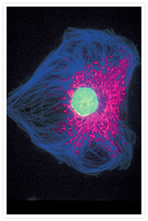Search Thermo Fisher Scientific
Vestibular labyrinth from turtle. Lysine-fixable 3000 MW tetramethylrhodamine dextran and BODIPY® FL phallacidin.
The attached eighth nerve from the vestibular labyrinth of a turtle, Pseudemys scripta, exposed to lysine-fixable 3000 MW tetramethylrhodamine dextran (Cat. no. D3308) and incubated with F-actin–specific BODIPY® FL phallacidin (Cat. no. B607). F-actin–labeled ciliary bundles were stained green by the phallacidin, and the calyceal and bouton endings of their primary afferents were stained red by the dextran. This image is a projection of 40 confocal images. Image contributed by Laura DiCaprio and Ellengene Peterson, Ohio University.

Related Products
Related Images
Bovine pulmonary artery endothelial cells (BPAEC). MitoTracker® Red CMXRos, SYTOX® Green nucleic acid stain, biotin-XX goat anti–mouse IgG antibody and Cascade Blue® NeutrAvidin biotin-binding protein. Go ›

Endothelial cells. Go ›

Dual-emission ratiometric measurement of lysosomal pH using LysoSensor™ Yellow/Blue dextran. Go ›

Rhizoid cells from the marine alga Fucus serratus were pressure-microinjected with 10,000 MW Calcium Green™-1 dextran and 10,000 MW Texas Red® dextran. Go ›
